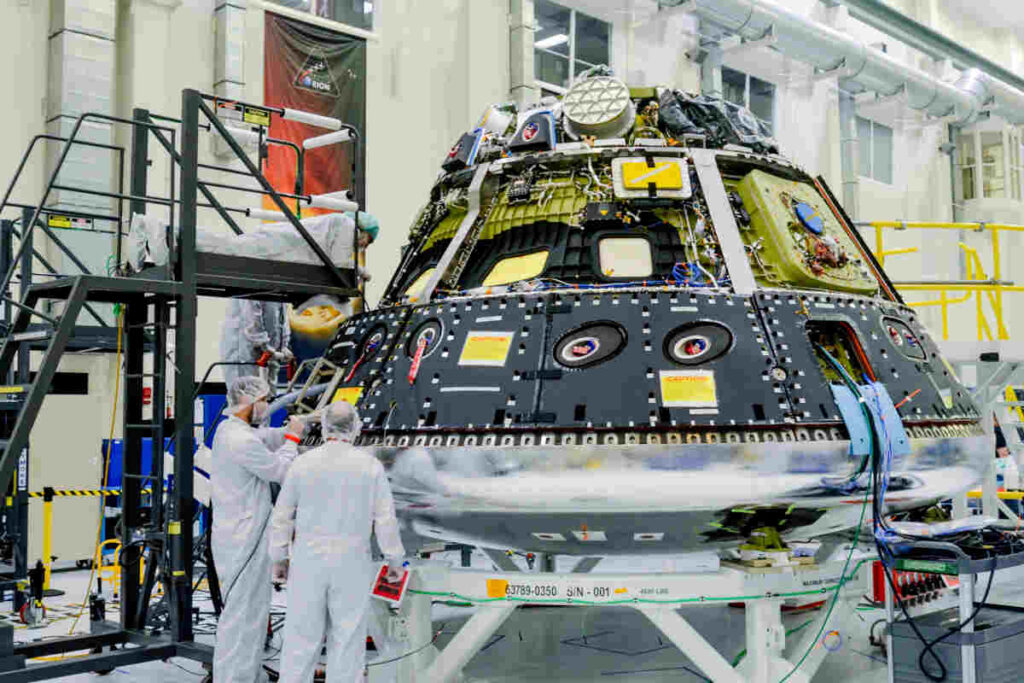
Features
Jeremy Hansen on first visit to Artemis II capsule: ‘It sent shivers down our spines’
August 9, 2023 By James McCarten, The Canadian Press
 Technicians work on the Orion crew module for NASA’s Artemis II mission inside the Neil A. Armstrong Operations and Checkout Building at the agency’s Kennedy Space Center in Florida. (Photo: NASA)
Technicians work on the Orion crew module for NASA’s Artemis II mission inside the Neil A. Armstrong Operations and Checkout Building at the agency’s Kennedy Space Center in Florida. (Photo: NASA) WASHINGTON — Reality seems to be sinking in for the man poised to become the first Canadian astronaut to fly around the moon.
“I already knew going to the moon was hard,” Jeremy Hansen quipped Tuesday at the Kennedy Space Center during an update on Artemis II, the first crewed voyage to lunar space in more than half a century.
“That’s why we’re doing it — I already knew it was hard. But boy, it’s harder than I thought.”
It was awe, not apprehension, in Hansen’s voice as he and his fellow crew members described their first up-close look at the systems, the hardware and the people that will propel them into space as early as next November.
“Seeing the capsule, for all of us, sent shivers down our spines as we saw it for the first time inside,” he said. “It makes an impression.”
That November 2024 timeline remains intact, officials say, with the caveat that things could still change given all the different components and variables that must line up for the mission to remain on schedule.
The last time human beings travelled that far was during the final Apollo mission in 1972. Artemis II will make Canada and the U.S. the only two countries to ever venture to the region beyond the dark side of the moon.
After twice orbiting Earth, the crew will rocket hundreds of thousands of kilometres for a figure-8 around the moon before their momentum brings them home.
The mission is a precursor to the next phase of Artemis: to put a man and woman on the moon as early as 2025 in service of eventually dispatching astronauts to Mars.
That is the ultimate objective, said Hansen, 47, a CF-18 fighter pilot from London, Ont.
“The success is not in the final solution, it’s not in the touchdown or the launch date,” he said.
“The success is in the learning that’s happening, like, right now — learning is happening right while we’re sitting here in stuff that is going to serve us on our ultimate objective, which is to get to Mars.”
The other three astronauts on the Artemis II mission are all American: mission commander Reid Wiseman, pilot Victor Glover and mission specialist Christina Hammock Koch.
But that hasn’t dampened international enthusiasm for the Artemis project, not least in Canada, said NASA Administrator Bill Nelson.
“You should have seen the reaction when Reid brought the crew to Ottawa and they were in front of Parliament,” Nelson said.
“Or you should have seen Jeremy in his 10-gallon hat at the largest rodeo in the world in Calgary, Alta. There’s an excitement there, I can tell you, that’s quite exceptional.”
There is also a measure of apprehension, however, when it comes to the timelines around Artemis III, the mission that will actually land on the lunar surface.
NASA will continue to hold key contractors to the existing schedule, which has a tentative launch date of December 2025, said NASA associate administrator Jim Free.
That includes Elon Musk’s SpaceX, which is developing a version of its Starship colossus — a Starship test failed in spectacular fashion over the Gulf of Mexico in April — to deliver the Artemis III crew and their lunar lander.
Free admitted he still has his doubts about whether the rocket will be ready.
“I think my concern is the same because they haven’t launched,” he said.
“They need to launch multiple times — not just for us, but for them. And then they need to launch multiple times for us. So we really want to see them find success in their launches, including the next one.”
There are also issues with the heat shield, which protects the underside of the capsule from the blistering temperatures associated with re-entry into Earth’s atmosphere.
During last year’s unmanned Artemis I test, the shield — designed to burn away during the re-entry process — did so less evenly than computer models had originally projected, a mystery engineers have yet to solve.
“Obviously, we’re going to make the right decision to keep them safe,” Free said.
“If that decision is we have to do something drastic, then we’ll do that. But right now we’re on a path to press to get to the root cause, and then we’ll make the final determination from there.”
Wiseman suggested Tuesday that Hansen has been talking about the prospect of putting the Artemis II capsule into a low lunar orbit, rather than the higher, elliptical pass that will be key to slingshotting the crew back home.
“Every day I go to work, Jeremy tells me that we’re putting this thing into low lunar orbit, and I keep telling him, ‘No, we are not,”’ he said, smiling at his crewmate.
As designed, the mission consists of two orbits of Earth before making its lunar pass, which will generate the momentum necessary to get the capsule home — the safest way to ensure Artemis II meets its objectives, Wiseman said.
“I really like the way safety is built into this mission profile,” he said. “I don’t think we’re going into lunar orbit on this one.”